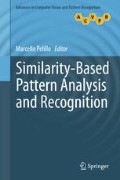Abstract
This introductory chapter describes the SIMBAD project, which represents the first systematic attempt at bringing to full maturation a paradigm shift that is just emerging within the pattern recognition and machine learning domains, where researchers are becoming increasingly aware of the importance of similarity information per se, as opposed to the classical (feature-based) approach.
Access this chapter
Tax calculation will be finalised at checkout
Purchases are for personal use only
Notes
- 1.
From: Artificial Cognitive Systems in FP7: A Report on Expert Consultations for the EU Seventh Framework Programme 2007–2013 for Research and Technology Development.
- 2.
A set of distances D is said to be Euclidean (or geometric) if there exists a configuration of points in some Euclidean space whose interpoint distances are given by D. In the sequel, the terms geometric and Euclidean will be used interchangeably. The term (geo)metric is an abbreviation to indicate the case of a distance that satisfies either the Euclidean or the metric properties.
References
Altschul, S.F., Gish, W., Miller, W., Meyers, E.W., Lipman, D.J.: Basic local alignment search tool. J. Mol. Biol. 215, 403–410 (1990)
Balcan, M.F., Blum, A., Srebro, N.: A theory of learning with similarity functions. Mach. Learn. 72(1–2), 89–112 (2008)
Biederman, I.: Recognition-by-components: a theory of human image understanding. Psychol. Rev. 94, 115–147 (1987)
Bridgman, P.W.: The Logic of Modern Physics. MacMillan, New York (1927)
Bunke, H., Sanfeliu, A.: Syntactic and Structural Pattern Recognition: Theory and Applications. World Scientific, Singapore (1990)
Dubuisson, M.P., Jain, A.K.: Modified Hausdorff distance for object matching. In: Proc. Int. Conf. Pattern Recognition (ICPR), pp. 566–568 (1994)
Duda, R.O., Hart, P.E., Stork, D.G.: Pattern Classification. Wiley, New York (2000)
Easley, D., Kleinberg, J.: Networks, Crowds, and Markets. Cambridge University Press, Cambridge (2010)
Edelman, S.: Representation and Recognition in Vision. MIT Press, Cambridge (1999)
Goldstone, R.L., Son, J.Y.S.: In: Holyoak, K., Morrison, R. (eds.) The Cambridge Handbook of Thinking and Reasoning, pp. 13–36. Cambridge University Press, Cambridge (2005)
Jacobs, D.W., Weinshall, D., Gdalyahu, Y.: Classification with nonmetric distances: Image retrieval and class representation. IEEE Trans. Pattern Anal. Mach. Intell. 22, 583–600 (2000)
Kleinberg, J.: Authoritative sources in a hyperlink environment. In: Proc. 9th ACMSIAM Symposium on Discrete Algorithms, pp. 668–677 (1998)
Lakoff, G.: Women, Fire, and Dangerous Things: What Categories Reveal About the Mind. University of Chicago Press, Chicago (1987)
Mayr, E.: The Growth of Biological Thought. Harvard University Press, Cambridge (1982)
Popper, K.R.: Conjectures and Refutations: the Growth of Scientific Knowledge. Routledge, London (1963)
Resnik, M.D.: Mathematics as a Science of Patterns. Clarendon, Oxford (1997)
Rorty, R.: A world without substances and essences. In: Philosophy and Social Hope, pp. 47–71. Penguin, London (1999)
Sen, P., Namata, G., Bilgic, M., Getoor, L., Gallagher, B., Eliassi-Rad, T.: Collective classification in network data. AI Mag. 29(3), 93–106 (2008)
von Luxburg, U., Williamson, R.C., Guyon, I.: Clustering: Science or art? In: JMLR: Workshop and Conference Proceedings, vol. 27, pp. 65–79 (2012)
Watanabe, S.: Pattern Recognition: Human and Mechanical. Wiley, New York (1985)
Author information
Authors and Affiliations
Corresponding author
Editor information
Editors and Affiliations
Rights and permissions
Copyright information
© 2013 Springer-Verlag London
About this chapter
Cite this chapter
Pelillo, M. (2013). Introduction: The SIMBAD Project. In: Pelillo, M. (eds) Similarity-Based Pattern Analysis and Recognition. Advances in Computer Vision and Pattern Recognition. Springer, London. https://doi.org/10.1007/978-1-4471-5628-4_1
Download citation
DOI: https://doi.org/10.1007/978-1-4471-5628-4_1
Publisher Name: Springer, London
Print ISBN: 978-1-4471-5627-7
Online ISBN: 978-1-4471-5628-4
eBook Packages: Computer ScienceComputer Science (R0)

